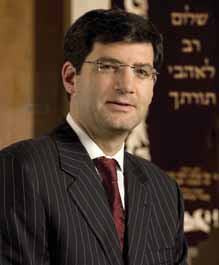Big-Tent Orthodoxy
It is a sad but well-known statistic that the largest and fastest-growing bloc of American Jewry is the unaffiliated. Depending on where in the United States you live, anywhere from 60 to 80 percent of the Jews in your city ages forty and under have no affiliation whatsoever to Judaism—they don’t belong to a synagogue or a JCC, they don’t contribute to Federation campaigns and they don’t even know an “Aleph” from a “Bet.” Sixty to eighty percent is a staggering number that we cannot afford to ignore.
One of the ways we at the OU are addressing this issue is through our Legacy Group, an outstanding cadre of thinkers and scholars in leadership positions who come together periodically to discuss and devise solutions to some of the most challenging concerns facing our communities across North America. Significant and recurring questions we ask at Legacy conferences are: How can we create real portals of entry into our Torah institutions for fellow Jews who are otherwise excluded? How can we be more inviting, more relevant and more inclusive of our brothers and sisters who may not yet think or observe the way we do but who are very much part of our family?
The first step in building a “big tent” is recognizing that our shuls are not simply places to daven, learn and socialize with friends whom we haven’t seen all week; our kehillot need to offer much more than that. We can offer a sense of community, a concept that is sorely lacking in a generation where people have hundreds of Facebook friends and Twitter followers but not much real human interaction. Being there for others during a simchah, an illness or a shivah by opening our homes or bringing food is second nature to us, but it is an alien notion to those who are not part of a close-knit community.
Our shuls should offer opportunities for social justice, aka tikkun olam. We should be involved in countless projects that contribute to the greater good of society—food and clothing drives, aid to storm victims, volunteering in soup kitchens and shelters—opportunities that appeal to everyone regardless of their level of knowledge or observance.
Our shuls should offer opportunities for Israel activism—such as participation in AIPAC or NORPAC—and synagogue members should host elected officials to advocate for Israel. One doesn’t have to have an Orthodox upbringing to love Israel and work for her security and well-being.
Step two: Recognize that sometimes you have to leave the tent to find the people you would like to bring in. Appropriate synagogue-related programming can and should take place in neutral, nonthreatening venues outside of the building. A barbecue in the park, continuing education in the workplace, a “Lunch and Learn” at a restaurant, a group outing to an art festival, the theater or a concert are all enjoyable programs that might be attractive to someone who isn’t comfortable going to a synagogue but would make a connection in a more familiar and relaxed setting.
Step three: Create an environment that is warm and welcoming. Note the Disney model: all Disney employees, from the parking lot attendants to the maintenance crew to the ticket and ice cream vendors, are trained to be friendly and inviting. Their mission is to make each person feel like an important guest. Before a visitor to Disneyland reaches the first ride, he or she is made to feel welcome. Our shuls must do this too. An unaffiliated Jew often feels uncomfortable and intimidated upon entering an Orthodox shul. But if he is greeted warmly by the security staff as soon as he approaches, and if he is ushered to a seat by someone who gives him a warm smile and a siddur with an English translation, all of the anxieties and fears of the unknown start to melt away. No one wants to be in a place where where he doesn’t feel comfortable. Let’s make sure to create a shul environment where everyone can feel like they belong.
Step four: The big-tent mentality has to permeate the entire congregation. No matter how talented and committed the shul rabbi and president are, they cannot singlehandedly be responsible for making a positive impression on every person who finds his way in. A newcomer will likely interact more with the individual person he is seated next to than the rabbi; that means those crucial first impressions are yours and mine to make. Will we go out of our way to talk to someone new and be helpful to him or her? Will we make a point of inviting him or her to our homes?
The Boca Raton Synagogue is at the forefront of the big-tent model. It has an outreach professional on staff and sponsors a “Share One Shabbos” (SOS) Friday evening, where virtually the entire congregation hosts someone who has never experienced the beauty of a Shabbat dinner. The shul even produced instructional videos to help people prepare for the SOS Shabbat dinner.
Kehilath Jeshurun on Manhattan’s Upper East Side hosts a wildly successful beginner’s minyan led by George Rohr. These are just a few examples of ways that shuls can create a welcoming culture that espouses our fellow Jews and exposes them to the meaning and beauty of a Torah life.
I have had the privilege of spending Shabbat in numerous communities across the country. I am proud to say that many of us are finding ways to make our shuls true “kehillot,” warm and open to all who wish to enter. Sadly, some of us still have work to do. Treating our batei knesset as a poor man’s country club tragically misses the opportunity to reach out and bring others in. Our brothers and sisters are slipping away. Let us bring them into our tent before it is too late.

